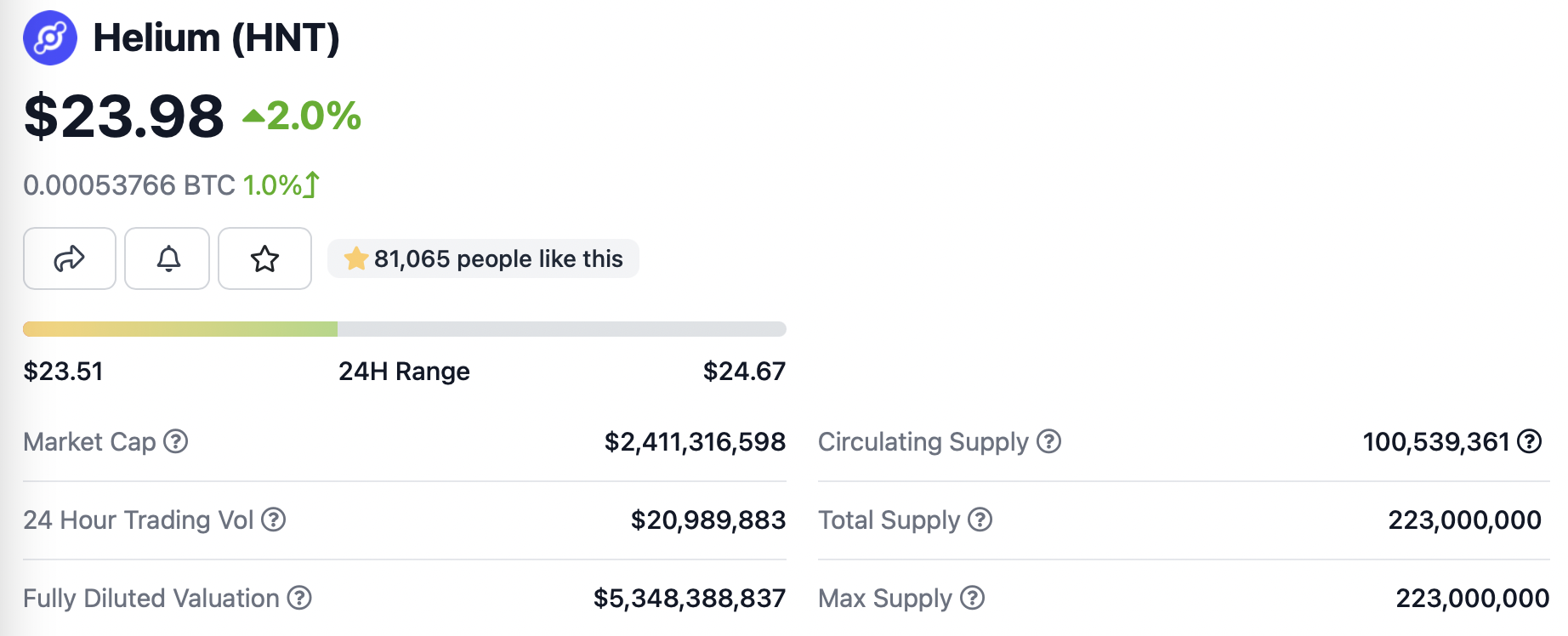A few weeks ago, I was asked for opinions on Helium, so I did some research on their website and tried to figure out what they are doing and how it works. In this post, I would like to share my personal views on this “decentralized wireless infrastructure”.
Disclaimer: I am NOT providing any financial or investment advice.

What is Helium?
In my opinion, it includes three layers:
- a globally distributed, LoRaWAN-enabled IoT network
- a blockchain that produces cryptocurrency called HNT
- a possible distributed 5G network
Distributed IoT network
On the first layer, a LoRa IoT network is nothing new, and it is a mature technique long age. However, a globally distributed wireless network is never seen before. Normally, an IoT network is owned by one company and the coverage is limited to a certain area, a house or a factory for example, where the hotspots are installed and maintained. If the IoT devices need to be deployed in a very large area, a city, or a country, for example, the to-go choice is using the existing cellular network, and the standards are LTE-M, NB-IoT, etc.
All these existing techniques can be categorized as centralized solutions, whereas the Helium network is claimed to be a distributed or decentralized solution. The hotspots are not owned by a company, but by individuals, the contributors. Anyone can buy a transceiver from Helium, plug it into their home network, and start hosting a hotspot. It is believed that as long as enough contributors host the hotspots around the world, the Helium network can have global coverage. According to their website, their devices transmit signals on the 915 MHz band (or 868 MHz in the EU). Although the hotspot is said to have long-range coverage with the sub-G Hz frequency, a global coverage still requires countless hotspots.

Cryptocurrency
So why the people would like to host and maintain the hotspots in the first place? The secret is the cryptocurrency: HNT. If you have ever heard of any kind of cryptocurrency, Bitcoin or Ethereum, the HNT is not much different. The HNT is rewarded to the hotspot hosts and can be converted to the data credit to access the Helium network. Most importantly, it is tradeable and cashable. The mining is not like other cryptocurrencies, you don’t need to run algorithms on expensive GPUs to prove your work, but to host hotspots and prove your coverage. The people who host the hotspots are compensated with the HNT which is equivalent to real money, so they have the motivation to host as many hotspots as possible. On the other hand, the users pay HNT to let their IoT devices access the Helium network, so they need to buy HNT on the market with real money. Sounds like a perfect closed loop.

Distributed 5G network
This blog gives some details regarding the future Helium 5G network. In summary, people buy 5G base stations (by FreedomFi) instead of IoT hotspots and the base stations will operate on the CBRS band. The CBRS stands for Citizens Broadband Radio Service and is a 150 MHz wide broadcast band of the 3.5 GHz band (3550 MHz to 3700 MHz) in the United States.
Don’t forget, it is also compensated with the cryptocurrency, HNT.
How I see the Helium network
When wireless meets blockchain
I have to say, as a wireless expert, I am very excited to see this innovation: the mature wireless technique wrapped by the hottest concept, so the traditional industry can also enjoy the dividends of blockchain technology. I am not saying it is a scam or outdated, the technique is solid and the potential applications are real. At least it is a real-life project, not just burning GPUs.
However, like all blockchain projects, speculation is inevitable. People flock in, and the only purpose is to mine the cryptocurrency as much as possible. It is helpful for the project to expand. The management team and the steak holders are happy to see this situation: the value of their cryptocurrency is soring, and they can cash out and achieve financial freedom.
The coverage issue
So far so good, but remember, Helium is not only a blockchain but also an IoT network. It has a specific application in the physical world: connecting things to the Internet. If I were to connect my product to an IoT network, what will be my consideration? A stable connection that covers all the possible areas is the priority, and the power consumption and the cost may come second.

The coverage map shows a lot of green dots in North America and Europe. This is “proof” of global coverage of the Helium network. But an illustration on this scale can be misleading. Are they represent the hotspots or coverage? Are these hotspots still active? Because if the HNT value goes down, just like other cryptocurrencies, the hotspot owners are not willing to turn on the hotspot all the time. In addition, to earn more HNT, it is best to deploy the hotspot close to other hotspots, so you will get more proof of coverage. So to deploy a hotspot to a rural area is not profitable, which may limit the expansion of its coverage.
Decentralization is both an advantage and a fatal disadvantage in terms of network coverage. A centralized telecom company provides a stable network and will not turn off a station due to a currency’s value. It will also build stations to expand its network coverage as reasonably much as possible.
Will decentralization prevail in the end? I don’t know, but I seriously doubt this decentralized IoT network.
The problem with 5G
Let’s talk about the Helium 5G network. I think this is more like a future vision to boost the HNT’s market value than a real application. We know the deployment of a 5G network is extremely expensive and requires domain expertise. Only China is capable to build the world’s largest 4G/5G network as well as other engineering wonders.
The personal host 5G station costs a few thousand dollars, not as expensive as a real 5G station, but still 10 times more than a LoRa hotspot (which I believe is also too expensive). The coverage area is much smaller than the LoRa hotspot due to the higher signal frequency. Not to mention that the CBRS band could be very noisy like the 2.4G ISM band. Do you really want your 5G phone works on an unstable, no coverage guaranteed network?
Most importantly, it is not secure. The base stations are hosted by individuals, and this sounds like an IMSI-catcher to me. If the station is hacked or the code is modified, all the traffic through your phone and your identity will be vulnerable to the third party.
Closing statment
So is it a scam? Maybe not. With these many flaws, HNT can still be valuable. There are so many kinds of cryptocurrencies that have no physical applications but are still popular. A cryptocurrency or any currency can be valuable as long as there is a backing story that many people believe.
But as an IoT network, I am not going to choose the decentralized Helium network to deploy my application, unless the coverage is assured in the area of interest.
Do you know there is another existing global “crowdsourcing” IoT network, that has billions of hotspots owned by the people, centralized management, and no cryptocurrency involved? That is Apple’s Find My network! 
Comments powered by Disqus.